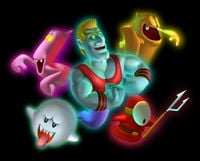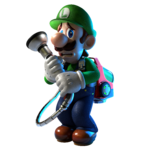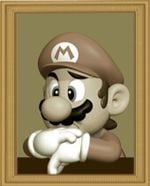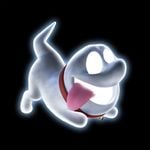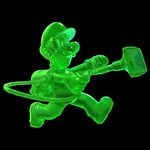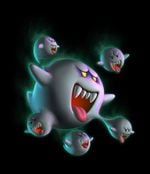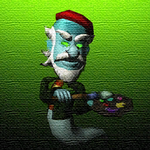Luigi's Mansion (series): Difference between revisions
Digibutter (talk | contribs) mNo edit summary |
Tag: Mobile edit |
||
| Line 71: | Line 71: | ||
|- | |- | ||
|align="center"|[[File:Luigis Mansion 2 HD US box art.jpg|150px]]<span style="font-size:8pt"><br>June 27, 2024<br>[[Nintendo Switch]] </span> | |align="center"|[[File:Luigis Mansion 2 HD US box art.jpg|150px]]<span style="font-size:8pt"><br>June 27, 2024<br>[[Nintendo Switch]] </span> | ||
|A [[Nintendo Switch]] [[Reissue#Remakes| | |A [[Nintendo Switch]] [[Reissue#Remakes|remake]] of ''Luigi's Mansion: Dark Moon'' was released on June 27, 2024. This version features updated graphics compared to the original release. | ||
|} | |} | ||
Revision as of 11:21, July 8, 2024
This article is under construction. Therefore, please excuse its informal appearance while it is being worked on. We hope to have it completed as soon as possible.
| Luigi's Mansion | |
|---|---|

| |
| First installment | Luigi's Mansion (2001) |
| Latest installment | Luigi's Mansion 2 HD (2024) |
| Number of installments | 6 (3 main, 1 arcade, 2 reissues) |
| Franchise | Super Mario |
The Luigi's Mansion series is a series of action-adventure video games with a few light horror elements. It spans over three different systems and consists of three different games. It is a spin-off from the Super Mario series. It is the only series within the Super Mario franchise to have all of its games feature Luigi as the main protagonist, instead of Mario. Throughout the series, Luigi explores various haunted buildings, taking on a ghost-hunting role by capturing various types of hostile ghosts. The series commenced with the release of the first Luigi's Mansion game as a launch title for the Nintendo GameCube.
Gameplay
The gameplay revolves around Luigi exploring various haunted locations solving puzzles and defeating ghosts. The player uses Luigi's Poltergust to stun and vacuum up ghosts. In the first game, the player would have to use the flashlight to stun ghosts' hearts once they were exposed. From the second game onwards players use the Strobulb to stun ghosts and then proceed to suck them up, but also a device known as the Dark-Light Device that would reveal objects that were hidden by spirit balls. This was used for puzzles and secret areas. The first game featured portrait ghosts that the player would have to defeat by exposing their heart through a certain method, whereas the third game has Boss Ghosts that are similarly required to be defeated through certain methods. All three games feature bosses, with the first having three and a final boss, the second having five and a final boss and the third having sixteen and a final boss. The first game features certain portrait ghosts such as Chauncey and Bogmire, the second game features a Possessor along with a mini-boss for each mansion, and the third game features Boss Ghosts such as Chambrea or Johnny Deepend. These ghosts are defeated by other, more complicated methods than simply stunning and sucking them up.
List of games
Main games
| Title | |
|---|---|
| Cover, original release, and system | Synopsis |
| Luigi's Mansion | |
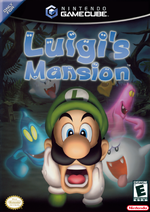 Template:Release Nintendo GameCube |
The first game and the original namesake for the overall series, Luigi's Mansion was released in 2001 as a launch title for the Nintendo GameCube. In the game, Luigi receives a message that he won his very own mansion in a contest he did not even enter. Puzzled by this, Luigi heads towards the mansion and meets Professor E. Gadd, who tells Luigi that his brother, Mario, has been captured by King Boo. King Boo made the mansion a mere illusion with intent to lure Mario and Luigi in order to capture the two. Luigi later learns that the evil ghost trapped Mario inside a portrait. Luigi is gifted with the Poltergust 3000 in order to vacuum ghosts and return them to their portraits. Luigi eventually defeats King Boo and frees his brother from his captivity. |
| Luigi's Mansion: Dark Moon | |
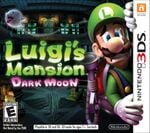 Template:Release Nintendo 3DS |
As a kickoff for the "Year of Luigi" and a revival of a series under a long hiatus, Luigi's Mansion: Dark Moon was released for the Nintendo 3DS in 2013. King Boo has somehow escaped from the painting which he was trapped inside and breaks the Dark Moon, an artifact that pacifies the ghosts it looks over. Due to its breakage, the Dark Moon's calming powers are nonexistent, causing the ghosts to become hostile. E. Gadd calls for Luigi to help restore the broken Dark Moon and bring peace back to the Evershade Valley. After collecting four out of the five pieces, Luigi learns that Mario has been taken hostage by King Boo again. Luigi, with the help of the Poltergust 5000, is able to conquer the mansion and defeat King Boo, freeing his brother once again. |
| Luigi's Mansion 3 | |
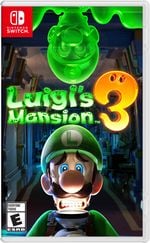 October 31, 2019 Nintendo Switch |
Luigi's Mansion 3 is the third main entry in the series, released for the Nintendo Switch on October 31, 2019 (the release coinciding with Halloween). In this installment, Luigi, Mario, Princess Peach, and various Toads are invited to a hotel called the Last Resort. Soon after they arrive, everyone but Luigi goes missing, having been turned into paintings by King Boo. To save them, Luigi has to navigate the many floors of the hotel with the help of E. Gadd, using a new Poltergust called the Poltergust G-00. The game also features 2-player co-op through Gooigi, who is given a much more prominent role in the story compared to his first appearance in the Luigi's Mansion remake. |
Arcade game
| Title | |
|---|---|
| Title, original release, and system | Synopsis |
| Luigi's Mansion Arcade | |
 Template:Release Arcade Machine |
Based off of Luigi's Mansion: Dark Moon, Luigi's Mansion Arcade was released in 2015, continuing a modern trend of arcade games returning to the Super Mario franchise. This game follows traditional, arcade-styled shooters in the sense that the user does not control where to go, as they are simply taken from location to location in order to defeat the ghosts. The controller for the game is based off the Poltergust 5000. The main objectives are to suck up the ghosts--similar to previous installments in the series--and to rack up a high score. |
Reissues
| Title | |
|---|---|
| Title, original release, and system | Synopsis |
| Luigi's Mansion | |
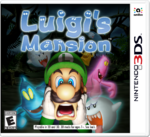 Template:Release Nintendo 3DS |
A Nintendo 3DS remake of Luigi's Mansion was released on October 12, 2018 in North America. This remake features updated graphics, a new co-op mode featuring Gooigi, the map on the Touch Screen, and a new Boss Rush mode. It led to the release of a Play Nintendo game in 2018 called Luigi's Mansion Fun Online Trivia Quiz. |
| Luigi's Mansion 2 HD | |
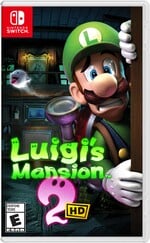 June 27, 2024 Nintendo Switch |
A Nintendo Switch remake of Luigi's Mansion: Dark Moon was released on June 27, 2024. This version features updated graphics compared to the original release. |
Characters
Protagonists
| Character | |
|---|---|
| Image | Description |
| Luigi | |
| The main protagonist of the series, the cowardly Luigi must fight his fears in order to rescue his brother and defeat King Boo, with the help of the different Poltergust models: the Poltergust 3000 in the first game and its remake, the Poltergust 5000 in the second game and spin-off, and the Poltergust G-00 in the third game. In the first game, Luigi's cowardice is greatly exaggerated, but as the series progresses, he becomes somewhat braver and less afraid of ghosts. Additionally, the first game gives Luigi extensive monologue via the Game Boy Horror, an aspect that is absent in later games. | |
| Professor Elvin Gadd | |
| Professor Elvin Gadd, or E. Gadd for short, is an elderly ghost researcher who invented the Poltergust series, among many other things, such as the Game Boy Horror, Dual Scream, Virtual Boo, Parascope, and Pixelator, all of which have helped Luigi throughout his adventures. E. Gadd also gives advice to Luigi. | |
| Mario | |
| Instead of being the main protagonist like in the Super Mario series, in the Luigi's Mansion series, Mario is the one in need of saving just like Princess Peach in the Super Mario series, as King Boo traps him within a painting. In Luigi's Mansion, Mario is somewhat impatient with Luigi and wants to be saved quickly, but in Luigi's Mansion: Dark Moon and Luigi's Mansion 3, he thanks him for his efforts. | |
| Polterpup | |
| A specific Polterpup who repeatedly makes trouble for Luigi in the second game. After the Dark Moon is restored, he returns to being well-behaved, and becomes Luigi's dog. He later reappears in the third game to help Luigi in his adventure; giving him tutorials and helping him capture ghosts by pulling Luigi back to make him able to drain the ghosts' health faster. | |
| Gooigi | |
| Gooigi is a clone of Luigi who appears in the Nintendo 3DS remake of Luigi's Mansion, as well as Luigi's Mansion 3. He appears in Luigi's image, but is entirely composed of green goo, hence his name, and wields a gooey version of the Poltergust 3000 and Poltergust G-00. He also has a letter "G" on his hat instead of an "L". He was created by the future Professor E. Gadd from Luigi's Mansion: Dark Moon. He is edible, and has been described as tasting like coffee. | |
Major Antagonists
| Character | |
|---|---|
| Image | Description |
| King Boo | |
| The leader of the Boos, King Boo is the main antagonist of the series. In the first game, he releases several of E. Gadd's captured portrait ghosts and tricks Mario and Luigi into thinking Luigi won a mansion in a contest. In the second, he destroys the Dark Moon to cause the friendly ghosts in Evershade Valley to turn hostile and takes on a much more serious tone compared to the previous game. In the third, he is released from his painting by Hellen Gravely, and retains his threatening tone from the second game. | |
| Boolossus | |
| A Big Boo composed of several smaller Boos, Boolossus appears as the third boss in the first game. Prior to the game's events, Boolossus had been captured by Professor E. Gadd, although King Boo attacked his lab and freed Boolossus, along with the rest of the portrait ghosts. Boolossus also appears in the ScareScraper in the third game. | |
| Vincent Van Gore | |
| A ghost artist who is responsible for all the minor ghosts that Luigi must capture in the first game, as well as the one who guards the key to the Secret Altar. | |
| Hellen Gravely | |
| A big fan of King Boo's and the owner of the Last Resort Hotel, she acts as an antagonist of Luigi's Mansion 3, where she captures Mario and several of his friends in paintings in order to impress King Boo. | |
Species
| Species | |
|---|---|
| Image | Description |
| Toads | |
| A typically timid species, Toads act primarily as save points in the first game. In the second game, they are E. Gadd's assistants, and hold footage from security cameras, but must be escorted to a Pixelator before it can be seen. In the third game, three Toads who came with Mario, Luigi, and Princess Peach are turned into paintings and have to be saved throughout the game and brought back to E. Gadd's Lab. | |
| Boos | |
| Spherical ghosts, most Boos prefer to hide and run instead of fight. In the first game, they must be sucked up to advance at certain points, but the light in the room they hide in must be turned on to do so. Once Luigi finds them, they try to escape to another room. In the second game, they use Spirit Balls to cast illusions, turning objects invisible, and exposing the correct object draws out the Boo. In the first game, there are 50, in the second, 32, and in the third, 16, most of which have their own pun-based name. | |
| Ghosts | |
| Ghosts are the various spectral enemies throughout the games. In the first game, most of them are creations of the ghost artist Vincent Van Gore brought to "life," in the second, the ghosts are normal inhabitants of Evershade Valley that turned hostile when the Dark Moon is shattered, and in the third, they work at the Last Resort hotel. The first game also contains the more powerful portrait ghosts, most of which have their own unique personalities and abilities, whereas the third game introduces Boss Ghosts, which are similar to the portrait ghosts from the first game but act as more traditional bosses. | |
Similarities between the games
- In all three games, Luigi nervously looks around while entering the first main mansion.
- All three games feature Mario being rescued from a portrait.
- All three games feature King Boo as the final boss.
Names in other languages
| Language | Name | Meaning | Notes |
|---|---|---|---|
| Japanese | ルイージマンション[?] Ruīji Manshon |
Luigi Mansion | |
| Chinese (simplified) | 路易吉洋馆[?] Lùyìjí Yángguǎn |
Luigi Mansion | |
| Chinese (traditional) | 路易吉洋樓[?] Lùyìjí Yánglóu |
Luigi Mansion | |
| Korean | 루이지 맨션[?] Ruiji Maensyeon |
Luigi Mansion |
References
